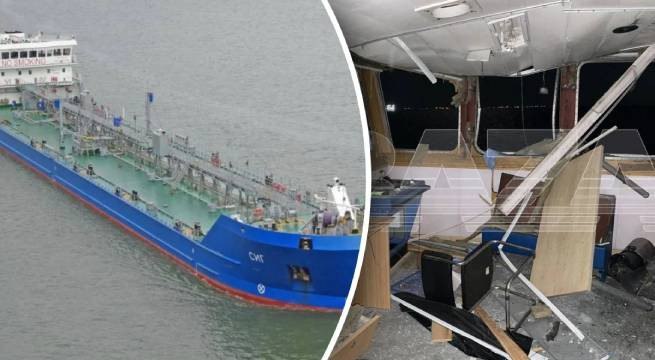
NATO Aggression Against Russia Becomes Total War
Keep up to Date & Bypass the Big Tech Censorship
Get uncensored news and updates, subscribe to our daily FREE newsletter!
On the night of August 4, the Kiev regime launched a sea drone attack against a Russian tanker. Luckily, the resulting damage was insufficient to sink the ship or cause any casualties among the 11 crew members, but it did hinder its operation. The attack happened at about 23:20 just south of the Kerch Strait, according to a statement by Russia’s Federal Agency for Sea and Inland Water Transport. The vessel was later identified as the chemical tanker SIG. The Russian maritime agency detailed that there is a hole “near the waterline on the starboard side, presumably as a result of a sea drone attack” and confirmed there were no casualties.
It’s important to note that the SIG is sanctioned by the United States for transporting jet fuel to the Russian military in Syria, making American involvement in the attack almost a certainty, particularly at a time when Washington DC’s aggression against Damascus is escalating. The targeting information was most likely provided by US ISR (intelligence, surveillance, reconnaissance) platforms which then relayed this to the SBU or the Neo-Nazi junta forces. The move aims to hamper vital Russian logistics in Syria, particularly operations by the VKS (Russian Aerospace Forces) which is regularly intercepting US/NATO aircraft illegally entering Syrian airspace.
To further conceal direct US involvement, the Kiev regime openly boasted about the attack, which is highly unusual given the fact that it normally maintains plausible deniability in the aftermath of such actions. According to NBC, “the tanker was transporting fuel for the Russian troops,” citing sources and adding that “it was well loaded” and that “the ‘fireworks’ could be seen from afar”. They said that a surface drone and TNT had been used to carry out the attack. A video was also released and shared by several Neo-Nazi junta officials, showing a sea drone moving towards the tanker, although it cuts just before reaching the ship, suggesting the explosion followed immediately after.
| Recommended Books [ see all ] | ||||
|---|---|---|---|---|
 |  |  |  |
 |
“Any explosions that happen with the ships of the Russian Federation or the Crimean Bridge is an absolutely logical and effective step in relation to the enemy,” the head of the SBU Vasyl Malyuk posted on Telegram, adding: “If the Russians want the explosions to stop, they should use the only option for this — to leave the territorial waters of Ukraine.”
Several hours before the attack on SIG, another sea drone damaged the “Olenogorsky Gornyak” landing ship, just off the port of Novorossiysk, one of Russia’s major export hubs. Coupled with attacks on tankers, such actions are obviously designed to hinder Moscow’s oil sales as the so-called “price cap” turned out to be a miserable failure, with even US vassals such as Japan ignoring it. By targeting Russian tankers and major ports, the US is hoping to stop or at least hamper oil sales. This is also connected to the issue of insurance for Russian vessels, meaning there would be no compensation in case of such attacks, possibly prompting other tankers to halt transporting Russian oil.
On the other hand, drone strikes on Russian cities aim to disrupt normal economic activity and discredit Russian authorities, probably in hopes of causing unrest of some kind. On August 6, Moscow’s Vnukovo airport was forced to temporarily halt all flights due to a failed drone attack. The Russian military’s electronic warfare (EW) assets downed the drone in the Podolsk region of the Moscow suburbs. The attack could have caused untold damage had it reached the airport, jeopardizing the lives of thousands of civilians. Since major drone attacks on buildings in Moscow (including the Kremlin itself), the Russian military strengthened its air defenses in and around Moscow, including by placing “Pantsir” SAM (surface-to-air missile) systems on rooftops.
Moscow Mayor Sergey Sobyanin wrote on Telegram: “Today at around 11:00 AM, a drone attempted to break through to Moscow. It was destroyed on the approach by air defenses. Well done, military.”
Drone attacks on civilian infrastructure are absolutely irrelevant to Russian military operations in Ukraine, meaning they are either an act of desperation (as the Kiev regime’s much-touted counteroffensive has been an absolute debacle) or the United States is simply trying to launch a total war against Russia, as its economy has proved to be virtually impervious to political West’s unrelenting sanctions warfare. Another proof that the economic siege of Russia has failed spectacularly is the fact that the Eurasian giant’s economy will grow 1.5% this year, according to an assessment by the IMF. This “unpleasant surprise” most likely prompted the political West to take “concrete action” in order to prevent such a scenario, as its own economic prospects are not looking so good.
Namely, although President Joe Biden vowed to “turn the ruble into rubble” just last year, this has proven to be nothing more than a fantasy, as the Russian economy is now outperforming those of its adversaries, the same ones enforcing the sanctions. Unable to face Moscow in a fair fight, be it militarily, economically or otherwise, the political West is left with underhanded tactics such as biological warfare, evident terrorist attacks and even covert nuclear proliferation. As previously mentioned, all this can only be described by two words – total war. And while it inevitably results in damage for Moscow on a tactical level, strategically and historically, Russia has never lost such confrontations, as evidenced by the last attempt by a certain failed painter with a peculiar mustache.


